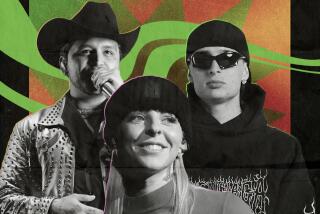Intoxicating foray into the exotic
Imbued with their own brand of pyrotechnic physicality, members of the locally based Viver Brasil Dance Company shredded the stage of John Anson Ford Amphitheatre on Saturday. In its sixth season at the venue, the troupe, founded in 1997 and directed by the husband-and-wife team of percussionist Luiz Badaro ( and Linda Yudin, presented “The Gift on the Water/Omi Odara.”
And what a gift it was. Rooted in traditional and contemporary dance idioms of Bahia (on Brazil’s northeastern coast), Rosangela Silvestre’s intoxicating choreography showcased an abundance of undulating Afro-Brazilian polyrhythms in four pieces, including two premieres. Also fueling her work: Candomble, Bahia’s white magic religion, its dances based on orixas -- deities -- and myths in this exhilarating, often trance-like foray into the exotic.
A trio of female water orixas were honored in the new “Three Waters/Tres Aguas.” Laila Abdullah, Shelby Williams and Dani Lunn proved a sea of whipping arms, sensual hip-swaying and dips galore as ocean, rainwater and river goddesses, respectively. Guest cellist Joyce Rooks provided an elegiac accompaniment to the rocking, take-no-prisoners’ percussion quartet, anchored by Badaro and original Viver Brasil member Mario Pallais, with a special appearance by Jose Ricardo Sousa.
Guest crooner Katia Moraes also filled the night air with a rapturous and soulful sound. In “Identidade/Identity,” from 2007, which featured Andriana Mitchell, Katiana Rush, Abdullah and Williams in contemporary mode, Moraes chanted phrases, such as: “Dance connects me with the universe, dance connects me with you.” The ladies, heeding this aphoristic call, lunged, leaped and high-kicked to the narration, their butterfly-like arms a kind of wistful prayer.
With the entrance of capoeira guru Gustavo Caldas, the work seamlessly flowed into a rousing finale, “So Moved (In Motion),” the evening’s other premiere. Dazzling the nearly full house with double-jointed shoulder gyrations, armless cartwheels and helium-like jumps, Caldas quaked and quivered to the accelerating percussion grooves, including those from Sandie Castaneda on drums. Unisons and dervish-like spinning punctuated the throbbing mountain of sound -- also featuring cymbals, timbaus, surdos and triangles -- as the dancers took virtuosic solo turns reminiscent of a hip-hop circle.
Costumes again supplied an orgy of colors and fabrics, with Eileen Cooley’s lighting another mood booster. Viver Brasil, kick-starting the concert with the previously reviewed “Mothers and Sons” (2006), is a perennial party onstage and, indeed, a Los Angeles treasure.
More to Read
The biggest entertainment stories
Get our big stories about Hollywood, film, television, music, arts, culture and more right in your inbox as soon as they publish.
You may occasionally receive promotional content from the Los Angeles Times.










